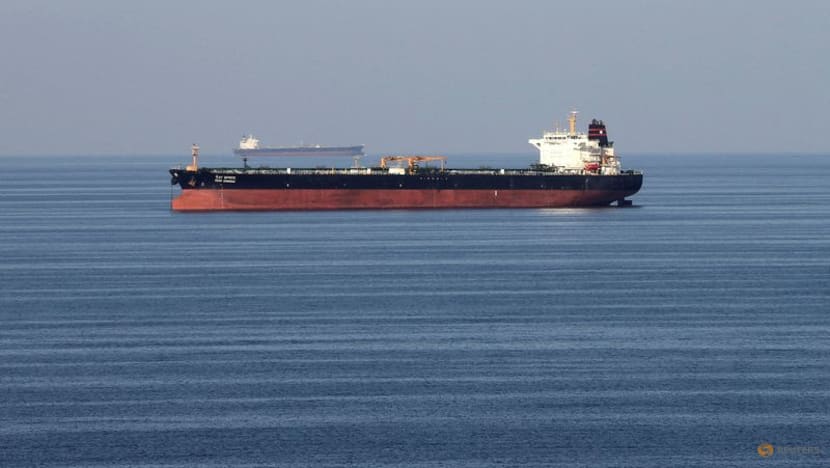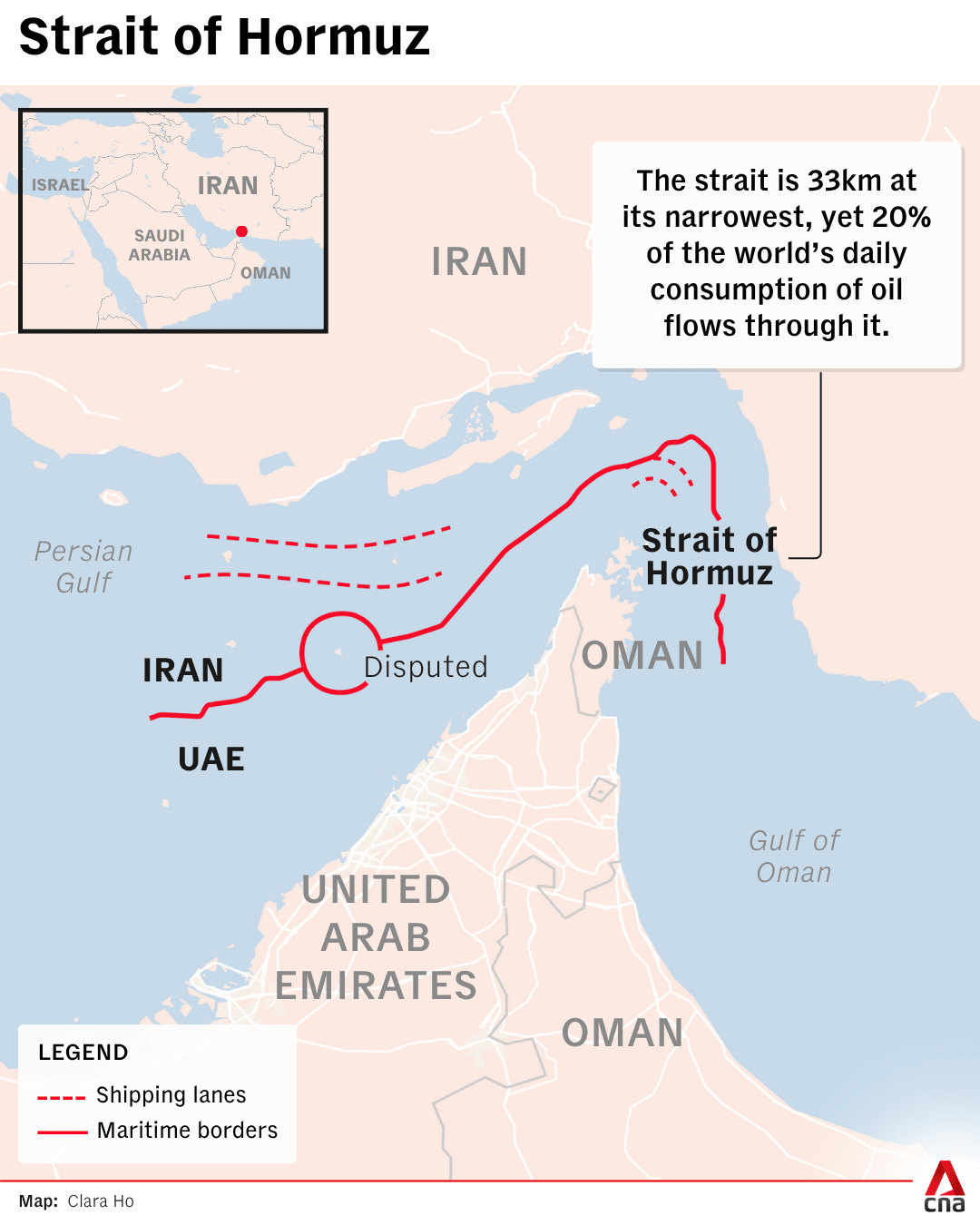What is the Strait of Hormuz, and could Iran block it?

Oil tankers pass through the Strait of Hormuz, on Dec 21, 2018. (Photo: REUTERS/Hamad I Mohammed)

This audio is generated by an AI tool.
The United States bombed Iran’s three main nuclear sites in a major escalation of this month’s conflict in the Middle East. Tehran said it will reserve all options to defend itself.
This US move has stoked speculation that Iran’s leadership may reach for another way to pressure its enemies to relent - blocking or effectively closing the Strait of Hormuz to shipping.
This narrow waterway at the mouth of the Persian Gulf handles about a quarter of the world’s seaborne oil trade.
So if Iran were able to deny access to the giant tankers that ferry oil and gas to China, Europe and other major energy consuming regions, it would send oil prices shooting higher and potentially destabilise the global economy.
Iran has targeted merchant ships traversing the choke point in the past, and has threatened to block the strait over the years.
Before the US strikes, oil shipping from the region and Hormuz, had been relatively unscathed by the conflict.
Shipments from Iran itself have surged, and oil tanker activity through the Strait of Hormuz remained largely steady. However, Greece’s shipping ministry on Sunday advised the nation’s vessel owners to review the use of the strait.
WHERE IS THE STRAIT OF HORMUZ?
The waterway connects the Persian Gulf to the Indian Ocean, with Iran to its north and the United Arab Emirates and Oman to the south. It’s about 161km long and 33.8km wide at its narrowest point, with the shipping lanes in each direction just 3.2km wide.
Its shallow depth makes ships potentially vulnerable to mines, and the proximity to land - Iran, in particular - leaves vessels open to attack from shore-based missiles or interception by patrol boats and helicopters.
The strait is essential to the global oil trade. Tankers haul about 16.5 million barrels of crude and condensate a day from Saudi Arabia, Iraq, Kuwait, the United Arab Emirates and Iran through the strait in 2024, according to data compiled by Bloomberg.
The strait is also crucial for liquefied natural gas, or LNG, with more than one-fifth of the world’s supply - mostly from Qatar - passing through during the same period.

COULD IRAN REALLY BLOCK THE STRAIT OF HORMUZ?
Iran would have no legal authority to order a halt to traffic through Hormuz, so would need to achieve this by force or the threat of force.
If its navy tried to bar entry to the strait, it would likely be met with a strong response from the US Fifth Fleet and other Western navies patrolling the area.
But it could cause severe disruption without a single Iranian warship leaving port. One option would be to harry shipping with small, fast patrol boats. Or it could launch drones and fire missiles toward ships from coastal or inland sites. That could make it too risky for commercial ships to venture through.
Similar tactics have been employed successfully by the Houthi militia in Yemen to disrupt traffic through the Bab el-Mandeb strait leading into the Red Sea on the other side of the Arabian peninsula.
The Houthis have mostly fired missiles and drones at ships after warning owners of vessels linked to the US, the United Kingdom and Israel that they will be attacked if they approach the area.
A US-led force in the Red Sea is seeking to protect shipping there. But the number of ships sailing through the Red Sea and Gulf of Aden was still down about 70 per cent in June compared with the average level of 2022 and 2023, according to Clarkson Research Services Ltd, a unit of the world’s largest shipbroker.
This has forced vessel operators to reroute their traffic around the southern tip of Africa instead of going through the Suez Canal - a lengthier and more expensive journey for ships travelling between Asia and Europe.
Closing the Strait of Hormuz would quickly hit Iran’s own economy as it would prevent it from exporting its petroleum. And it would antagonise China, the biggest buyer of Iranian oil and a critical partner that has used its veto power at the UN Security Council to shield Iran from Western-led sanctions or resolutions.
WHEN HAS IRAN DISRUPTED SHIPPING?
Iran has used harassment of ships in the Gulf for decades to register its dissatisfaction with sanctions against it, or as leverage in disputes.
- In April 2024, hours before launching a drone and missile attack on Israel, Iran’s Islamic Revolutionary Guard Corps seized an Israel-linked container ship near the Strait of Hormuz. Iran released the ship’s crew the following month, according to trade publication Lloyd’s List. Tehran claimed that the MSC Aries had violated maritime regulations, but analysts pointed to its Israeli ownership connection as a motive.
- When it seized a US-bound tanker in April 2023, Iran said the ship had struck another vessel. But the move appeared to be retaliation for the seizure off Malaysia’s coast of a ship loaded with Iranian crude by US authorities on the grounds of sanctions violations.
- In May 2022, Iran seized two Greek tankers and held them for six months, presumably a response to the confiscation by Greek and US authorities of Iranian oil on a different ship. The cargo was eventually released and the Greek tankers freed. So, too, was the oil on a tanker that Iran said it impounded in January "in retaliation for the theft of oil by the US".
HAS IRAN EVER CLOSED THE STRAIT OF HORMUZ?
Not so far. During the 1980-88 war between Iraq and Iran, Iraqi forces attacked an oil export terminal at Kharg Island, northwest of the strait, in part to provoke an Iranian retaliation that would draw the US into the conflict.
Afterward, in what was called the Tanker War, the two sides attacked 451 vessels between them. That significantly raised the cost of insuring tankers and helped push up oil prices. When sanctions were imposed on Iran in 2011, it threatened to close the strait, but ultimately backed off.
Commodore Alireza Tangsiri, head of Iran’s Islamic Revolutionary Guard Corps naval forces, said shortly before the MSC Aries seizure that Iran has the option of disrupting traffic through the Strait of Hormuz, but chooses not to.
HOW DID THE US AND ALLIES RESPOND TO THREATS TO HORMUZ SHIPPING IN THE PAST?
During the Tanker War, the US Navy resorted to escorting vessels through the Gulf. In 2019, it dispatched an aircraft carrier and B-52 bombers to the region. The same year, the US started Operation Sentinel in response to Iran’s disruption of shipping.
Ten other nations - including the UK, Saudi Arabia, the United Arab Emirates, and Bahrain - later joined the operation, known now as the International Maritime Security Construct. Since late 2023, much of the focus on protecting shipping has switched away from the Strait of Hormuz and onto the southern Red Sea, the region’s other vital waterway, and the Bab el-Mandeb Strait that connects it to the Gulf of Aden and the Indian Ocean. Attacks by the Iran-backed Houthis on shipping entering or exiting the Red Sea became a greater concern than the Strait of Hormuz.
WHO RELIES MOST ON THE STRAIT OF HORMUZ?
Saudi Arabia exports the most oil through the Strait of Hormuz, though it can divert shipments to Europe by using a 1,229km pipeline across the kingdom to a terminal on the Red Sea, allowing it to avoid both the Strait of Hormuz and the southern Red Sea. The UAE can export some of its crude without relying on the strait, by sending 1.5 million barrels a day via a pipeline from its oil fields to the port of Fujairah on the Gulf of Oman to the south of Hormuz.
With its oil pipeline to the Mediterranean closed, all of Iraq’s oil exports are currently shipped by sea from the port of Basra, passing through the strait, making it highly reliant on free passage. Kuwait, Qatar and Bahrain have no option but to ship their oil through the waterway. Most of the oil passing through the Strait of Hormuz heads to Asia.
Iran also depends on transit through the Strait of Hormuz for its oil exports. It has an export terminal at Jask, at the eastern end of the strait, which was officially opened in July 2021. The facility offers Tehran a means to get a little of its oil into the world without using the waterway and its storage tanks were slowly being filled with crude late last year.
















